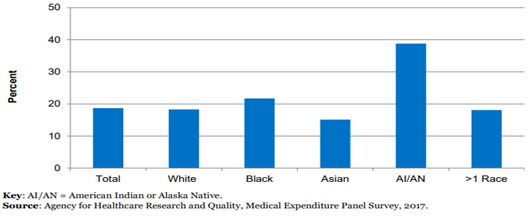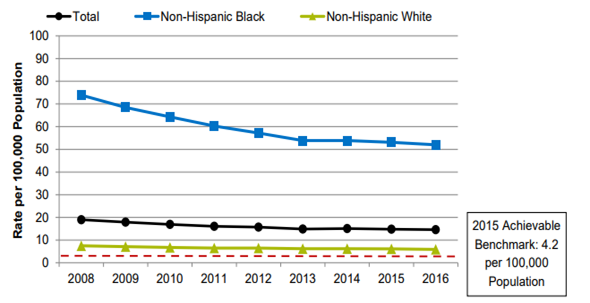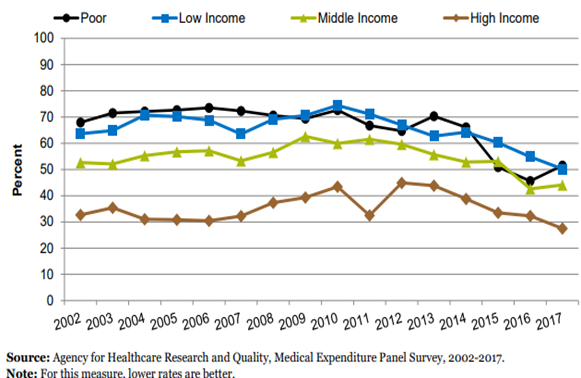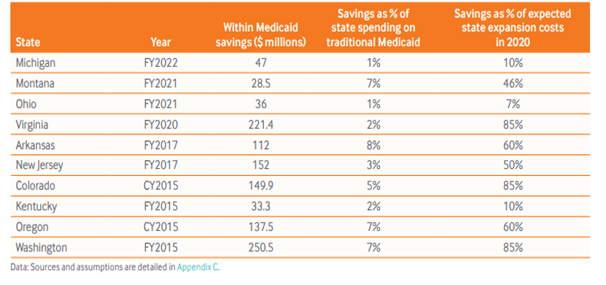BHA FPX 4020 Assessment 3 Data Collection and Analysis
BHA FPX 4020 Assessment 3 Data Collection and Analysis
Data Collection and Analysis
Health disparities in the US pose a challenge by compromising the ability to provide timely, affordable, and quality care. According to the Agency for Healthcare Research and Quality (AHRQ) (2021), healthcare disparities entail differences between population groups that determine how they access, experience, and receive healthcare services.
When elaborating on the problem of widening health inequalities, it is essential to incorporate the role of social determinants of health (SDOH) into the discussion. In this sense, synergies between ethnic, socioeconomic, environmental, and locational factors contribute to inequalities regarding access to care, care coordination, perceptions of patient safety, and care affordability.
As a country of demographic and socioeconomic diversities, the US needs to understand the interactions between health disparities. Therefore, data collection and analysis emerge as a profound strategy for enhancing knowledge and inspiring evidence-based practice for addressing health inequalities. As a result, this assessment presents data regarding various health inequalities while proposing evidence-based strategies for addressing health disparities.
Data Presentation
Figure 1: People under age 65 with any period of uninsurance during the year, by race, 2017

Figure 2: New HIV cases per 100,000 population aged 13 and over, 2008-2016

Source: Agency for Healthcare Research and Quality (AHRQ)
Figure 3: People unable to get or delayed in accessing medical care due to financial or insurance reasons, 2002-2017

Figure 4: Effects of Medicaid Expansion on States’ Healthcare Expenditures

Source: The Commonwealth Fund
Quantitative and Qualitative Analysis of Data
As noted earlier, health disparities influence how people access, experience, and receive healthcare services. In the United States, health inequalities manifest via various domains, including access to person-centered care, patient safety, healthy living, effective treatment, care coordination, and care affordability (Agency for Healthcare Research and Quality, 2021).
In this sense, national and state health organizations set achievable benchmarks based on concepts from each domain. For example, organizations emphasize adverse drug events in patients with anticoagulants, urinary tract infections, and medication safety when establishing patient safety benchmarks. These sub-themes enable healthcare institutions to compare their performance with top-performing institutions.
Since health inequalities are diverse and beyond one measure of quality, it is essential to focus on areas that demonstrate widening gaps within the social determinants of health (SDOH). In this sense, analyzing quantitative and qualitative data from national healthcare organizations such as the Agency for Healthcare Research and Quality (AHRQ) is essential to identify priority areas that demonstrate significant inequalities.
The first graph represents quantitative data regarding the problem of uninsured people under the age of 65 years. The graph makes it possible to identify disparities in access to insurance coverage among people of different ethnic backgrounds, including White, Black Americans, Asian Americans, American Indians or Alaska Natives (AI/AN), and people of more than one race.
The graph indicates that in 2017, (AI/ANs) under age 65 were twice as likely to lack insurance as whites (38.8% compared with 18.3%). Also, Black Americans were more likely than Whites to have a period of uninsurance in 2017 (21.7% compared with 18.3%). While health disparities hamper access to insurance coverage for ethnic groups, this data from the Agency for Healthcare Research and Quality (AHRQ) can inform recommendations for addressing health inequalities within the national insurance models.
Another ideal measure of health disparities is the prevalence of new HIV cases among people aged 13 and above. In Figure 2, the Agency for Healthcare Research and Quality (AHRQ) (2021) indicates the inequalities regarding new HIV cases in 2016. The graph indicates that non-Hispanic Blacks reported 52.0 new HIV cases per 100000 population for people aged 13 and above compared with 5.9 per 100000 cases for non-Hispanic Whites.
Although these numbers did not match the 2015 national achievable benchmark of 4.2 cases per 100000 population, they signify underlying conditions that create imbalances in the quality of life across the two groups. Therefore, the data shed light on areas where the federal and state governments should improve to reduce health inequalities.
Apart from the prevalence of new HIV cases and the number of uninsured people across populations, income issues are essential determinants of health disparities. In Figure 3, it is evident that poor and low-income people grapple with the problem of delayed care compared to middle-and-high-income people.
The graph indicates that 51.5% of the poor faced the challenge of delayed care in 2017 due to financial or insurance reasons. Although the income disparities narrowed from 2002 to 2017, poor and low-income people endure delayed care due to financial or insurance reasons. Therefore, national and state governments can use such data to initiate programs to reduce income inequality.
Evidence-Based Recommendations
Healthcare organizations in the US operate to promote care quality, timeliness, equality, and affordability. However, the prevailing health disparities affect how people access, experience, and receive healthcare services. In the current healthcare systems, external evidence significantly influences organizations’ practices and informs clinical decisions. While health inequalities rely massively on discrepancies within the social determinants of health (SDOH), it is vital to implement recommendations from reputable sources to address these disparities. These recommendations include:
Medicaid Expansion
The United States lacks a universal insurance model for providing health coverage to vulnerable groups. The absence of universal public insurance coverage exacerbates the problem of uninsured people, leading to expensive insurance premiums and complex health reimbursement models.
According to Radley et al. (2021), nearly 30 million Americans are still uninsured and are disproportionately people of color. Although the Affordable Care Act (ACA) 2010 required states to expand Medicaid, the revised eligibility criteria exclude poor and low-income people. As a result, they are ineligible for Medicaid coverage, leading to multiple ramifications, including limited access to quality care, the problem of delayed care due to financial or insurance issues, and compromised quality of life.
Although Medicaid expansion is an ideal strategy for addressing income-related health disparities, it is essential to establish its cost-benefit analysis to ensure its economic plausibility. Since Medicaid is a federal insurance policy, its expansion can alter national healthcare expenditures. However, states are more likely to save the cost of healthcare outside Medicaid services.
Ward (2020) argues that Medicaid expansion reduces states’ spending in various areas, including mental health and substance abuse treatment, corrections, and uncompensated care. The qualitative data in Figure 4 present savings estimates from traditional Medicaid and Medicaid expansion for selected states in different fiscal years. It is vivid that expanding Medicaid addresses disparities in access to quality care, care affordability, coordination, and patient safety.
Developing Community-Based Programs and Policies for Ensuring Health Equality
Medicaid expansion cannot singlehandedly address the prevailing health inequalities. Instead, health organizations and governmental agencies should embrace interdisciplinary collaboration to support community-based initiatives tackling health inequalities. According to Gomez et al. (2020), these localized programs should focus on various social determinants of health, including education, housing, healthcare justice, and literacy.
Also, they should compromise sub-themes such as attending to root causes of health inequalities and disparities, addressing issues that affect susceptible groups, promoting equal opportunities for all people to guarantee improved quality of life, and fair distribution of socioeconomic resources to promote healthy living.
Eliminating Structural Racism in Healthcare Organizations
Organizational cultures are consistent with patient safety, coordination, and patient-centered care. According to Lavizzo-Mourey et al. (2021), racial and ethnic disparities in healthcare organizations exist and are disproportionate to minority groups such as Black Americans and Asian Americans.
Such inequalities result in adverse health effects by compromising the tenets of patient-centered care, patient safety, and positive medical outcomes. As a result, addressing the underlying organizational barriers to equal healthcare service delivery is a profound strategy for tackling health discrepancies at the organizational level.
Conclusion
Undoubtedly, health inequalities and disparities cut across various domains, including access to person-centered care, patient safety, coordination, affordability, and effective treatment. Since the US grapples with social determinants of health discrepancies, it is essential to incorporate evidence-based strategies from quantitative and qualitative data regarding measures of health inequalities.
Figures 1, 2, and 3 present insights on various health discrepancies prevailing among ethnic and socioeconomic groups. Therefore, national and state governments should use such data to formulate policies and programs addressing health disparities. Evidence-based recommendations are Medicaid expansion, implementing community-based interventions to ensure equality, and eliminating structural racism in healthcare settings.
References
Agency for Healthcare Research and Quality. (2021). National Healthcare Quality and Disparities Report (pp. 1-316). AHRQ. https://www.ahrq.gov/sites/default/files/wysiwyg/research/findings/nhqrdr/2021qdr.pdf
Gómez, C., Kleinman, D., Pronk, N., Wrenn Gordon, G., Ochiai, E., & Blakey, C. et al. (2021). Addressing health equity and social determinants of health through Healthy People 2030. Journal of Public Health Management and Practice, s249-s257. https://doi.org/10.1097/phh.0000000000001297
Lavizzo-Mourey, R., Besser, R., & Williams, D. (2021). Understanding and mitigating health inequities — past, current, and future directions. New England Journal of Medicine, 384(18), 1681-1684. https://doi.org/10.1056/nejmp2008628
Radley, D., Baumgartner, J., Collins, S., Zephyrin, L., & Schneider, E. (2021). Achieving racial and ethnic equity in US health care: A scorecard of state performance. Accessed 5th February 2022 from https://www.commonwealthfund.org/publications/scorecard/2021/nov/achieving-racial-ethnic-equity-us-health-care-state-performance.
Ward, B. (2020). The impact of Medicaid expansion on states’ budgets. Accessed 5th February 2022 from https://www.commonwealthfund.org/publications/issue-briefs/2020/may/impact-medicaid-expansion-states-budgets.
BHA FPX 4020 Assessment 3
Apply a selected tool to an identified health care problem, analyze the qualitative and quantitative results, and provide evidence-based recommendations to address the problem based on analyses performed. Include a minimum of two visual data displays (charts, graphs, et cetera).
Health care has become a data-driven industry that practices evidence-based decision making. Whether the issue is clinical or financial, health care leaders are expected to analyze problems using logic, established tools, and data. Effective leaders engage team members in the problem resolution process, encouraging a wide variety of perspectives. Once the problem is clearly defined, the health care leader is responsible for selecting an appropriate, established framework or tool with which to analyze the problem. Research, critical thinking, and team collaboration are important facets of problem solving.
Health care organizations have finite resources, so the solving of problems must take place within the confines of the organization’s available resources. In this assessment you will practice estimating the cost of one recommendation and determining whether implementing the recommendation is realistic for a specific health care organization. You will apply a simple cost benefit analysis and make a recommendation. Cost benefit analysis is another important skill for health care leaders, and this assessment provides an opportunity for you to demonstrate critical thinking skills.
This assessment also provides the opportunity to reflect upon the industry and organizational contexts before engaging in application of a tool for problem analysis. You will consider the organization’s setting with respect to level of care, mission, strategy, operations, and culture. Moreover, you will think critically about legal, regulatory, ethical, and risk management operational issues that relate to the selected problem. Let’s get started.
Demonstration of Proficiency
By successfully completing this assessment, you will demonstrate proficiency in the course competencies through the following assessment scoring guide criteria:
Competency 1: Evaluate problems in health care organizations, and apply tools to improve quality and outcomes.
Provide rationale for the selected problem analysis model or tool.
Competency 3: Construct evidence-based health care management recommendations in compliance with personal and professional values and legal, regulatory, and ethical considerations.
Construct evidence based recommendations which may include ethical, legal, regulatory, and organizational standards.
Competency 4: Analyze records and reports based on established benchmarks and organizational goals and performance.
Analyze date relative to internal and external benchmarks.
Preparation for BHA FPX 4020 Assessment 3
As you prepare to complete this third course assessment, consider the organizational context. How does analysis of the problem align with the organization’s vision, mission, strategy and financial viability? Using numbers and organizational considerations, you will explain why the organization should or should not proceed with the recommendation.
Assessment 3 Instructions
This assessment consists of three parts.
Data Presentation
In this part of the assessment, you will apply the selected tool to the problem and produce a minimum of two visual data displays (charts, graphs, et cetera). Examples of tools you might include are:
Cost Benefit Analysis: Excel spreadsheet, converted into 2–3 worksheet tabs, graphs, or other visual display format. Compliance Assessment: 3 major criteria converted into 3 separate pie charts or other graphic display format.
Lean Analysis: The percent of variance by major factor converted into 2–3 trend lines.
Note: At a minimum, provide a cost benefit analysis of the recommendation.
Quantitative and Qualitative Analysis of Data

In this part of the assessment you will analyze the collected data relative to benchmarks. Provide discussion as to whether the selected benchmarks are internal to the organization, external industry benchmarks, or a combination. Be sure to include a short summary of observations. Note: If the problem requires an additional tool, such as a compliance audit tool, you may include more than one discussion of the results.
Evidence-Based Recommendations
In this final part of the assessment, provide evidence-based recommendations that will help to address the identified problem. Be sure to support your recommendations with references to current, scholarly, and/or authoritative sources. Also include an explanation as to why the recommendations are feasible for this particular organization. For example, one recommendation might be to offer a new service line. Even though the new service may not generate an immediate profit, it might serve to draw additional patients into the network.
Additional Requirements
Length: The nature, breadth, and depth of the problem will drive the length of the recommendation and cost benefit analysis.
Font: Use Times New Roman, 12-point font.
APA: Follow APA formatting and style guidelines for citations and references
Related Assignments:
BHA-FPX 4020 Assessment 5 Instructions: Health Care Leadership Self-Assessment
